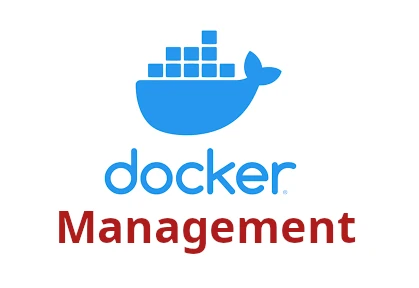Docker Management
Managing Docker environments efficiently involves not only cleaning up but also creating and maintaining containers, images, volumes, and more. Here’s a comprehensive guide to Docker management from cleanup to creation.
Table of Contents
Removing Docker Containers, Images, and Volumes
If you’re looking to clean up your Docker environment by removing containers, images, and volumes, using the command line, here’s how you can do it:
Removing Docker Containers
- List all containers: (This command lists all containers, displaying only their IDs.)
docker ps -aq- Delete all containers:
docker stop $(docker ps -aq) && docker rm $(docker ps -aq)docker stop $(docker ps -aq) ⟶Stops all running containers.
docker rm $(docker ps -aq) ⟶Removes all containers.
- Using Docker Container Prune Command (The
-fflag is used to force the deletion without asking for confirmation.)
docker container prune -f- Using Docker System Prune Command (The
-aflag removes all unused containers, and the-fflag is used to force the deletion without confirmation.)
docker system prune -a -fRemoving Docker Images
- List all images: (This command lists all images, displaying only their IDs.)
docker images -aq- Delete all images: (The
-fflag is used to force the deletion without asking for confirmation.)
docker rmi $(docker images -aq) -f- Using Docker System Prune Command (The
-aflag removes all unused images, and the-fflag is used to force the deletion without confirmation.)
docker system prune -a -fRemoving Docker Volumes
- List all volumes: (This command lists all volumes, displaying only their names or IDs.)
docker volume ls -q- Delete all volumes: (The
-fflag is used to force the deletion without asking for confirmation.)
docker volume prune -fRemoving Specific Volumes
(Replace [VOLUME_NAME or VOLUME_ID] with the name or ID of the volume you want to remove.)
docker volume rm [VOLUME_NAME or VOLUME_ID]Using Docker System Prune Command
(The --volumes flag removes all unused volumes, and the -f flag is used to force the deletion without confirmation.)
docker system prune --volumes -fCreating Docker Images
Creating Docker images is a fundamental aspect of Docker management. You can create Docker images using a Dockerfile or by committing changes to a container.
Using Dockerfile
- Create a
Dockerfile:
# Use an official base image
FROM ubuntu:latest
# Set environment variables
ENV APP_HOME /app
# Create directory
RUN mkdir $APP_HOME
# Set working directory
WORKDIR $APP_HOME
# Copy application files
COPY . .
# Run your application
CMD ["./your-app"]- Build the Docker image:
docker build -t your-image-name .Using Commit
- Run a container:
docker run -it --name temp-container ubuntu:latest /bin/bash-
Make changes in the container.
-
Commit changes to create an image:
docker commit temp-container your-image-nameInitializing Docker Projects
You can initialize a new Docker project using the docker init command. This command creates a new Dockerfile and a default .dockerignore file.
docker init your-project-nameUsing Docker Compose
Docker Compose is a tool for defining and running multi-container Docker applications. You can use a docker-compose.yml file to define your services, networks, and volumes.
- Create a
docker-compose.ymlfile:
version: '3'
services:
web:
image: nginx:latest
ports:
- "80:80"- Run Docker Compose: (This will start your services as defined in the
docker-compose.ymlfile.)
docker-compose upor
docker-compose up -d
docker-compose up -d command Starts up the services in the background (detached mode) without displaying the logs in the terminal. It’s ideal for production or when you want the services to run in the background while you continue working on other tasks.
Conclusion
Managing Docker environments efficiently is essential for streamlined development and operations. From cleaning up unused resources to creating Docker images and using Docker Compose, mastering these tasks enhances your Docker workflow.
For further exploration and advanced features, it is best to refer to the:
The official documentation provides comprehensive guides and references to help you leverage Docker’s full potential. Explore Docker’s powerful tools and best practices to optimize your containerization experience and simplify your development process.
max-width: 100%; } -->